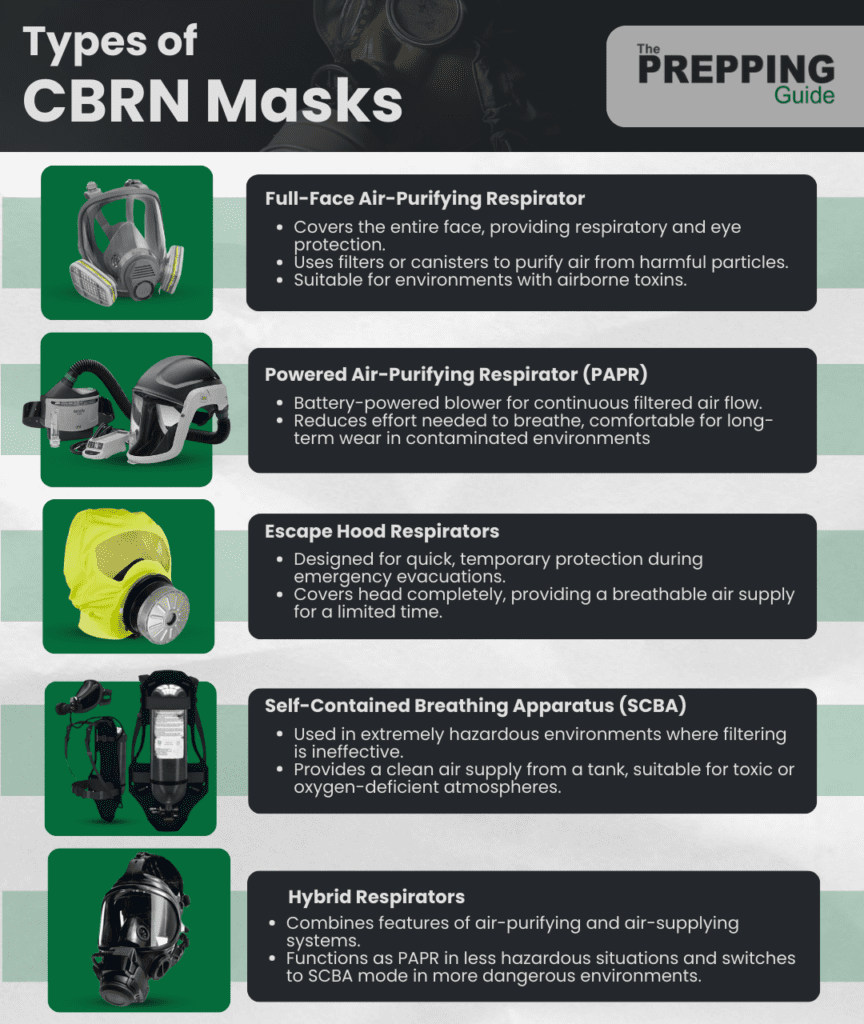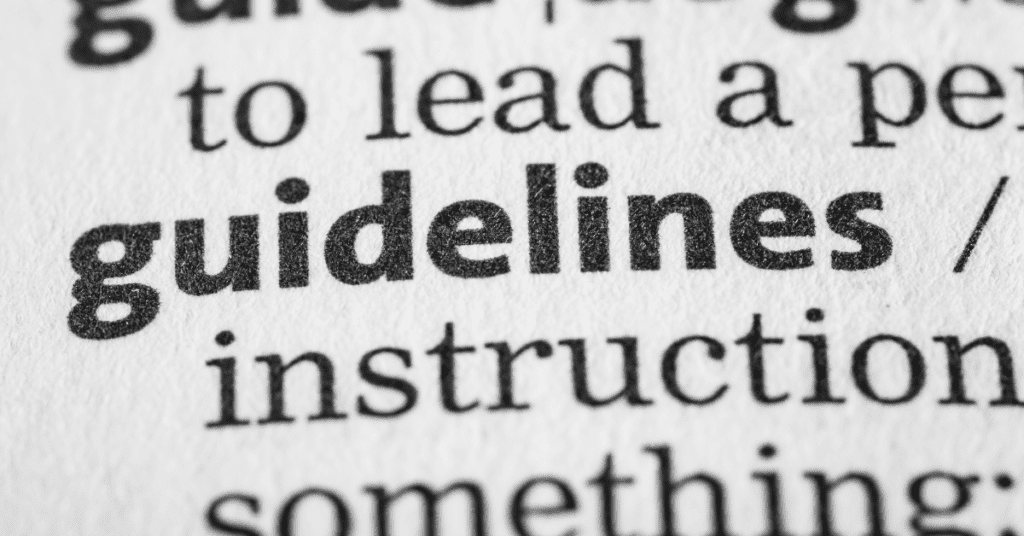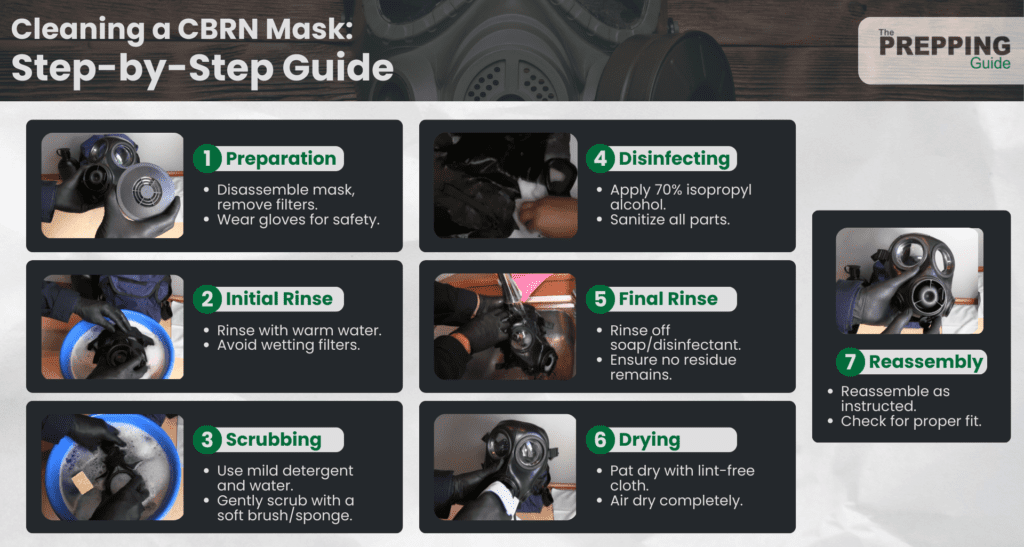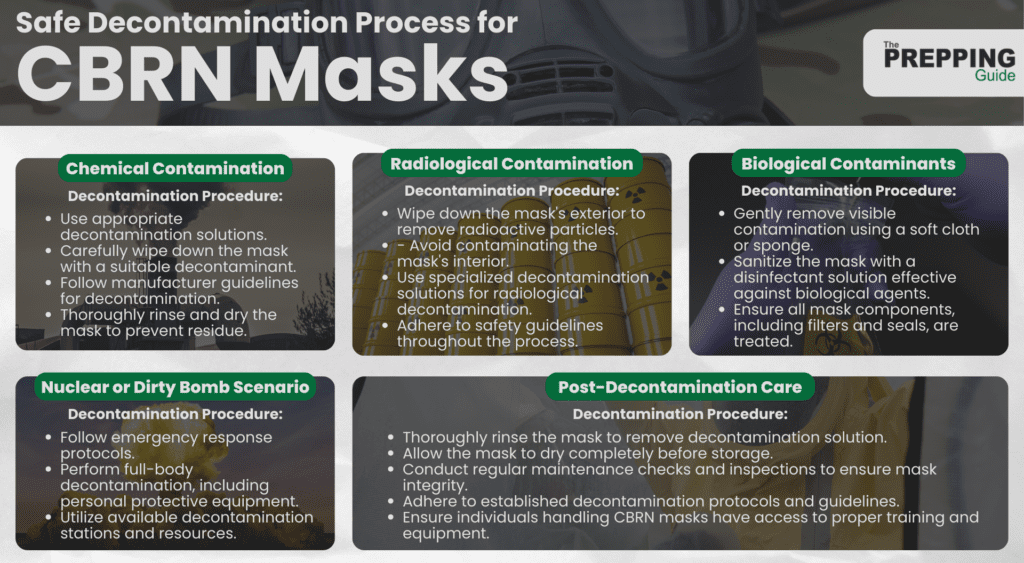When it comes to safety in hazardous environments, knowing how to clean CBRN masks is crucial. This guide provides a comprehensive overview to ensure your mask is always ready for use.
To clean a CBRN mask, disassemble it, gently wash each part with a mild detergent, rinse thoroughly, and allow it to dry completely. Regular inspection, maintenance, and proper storage are essential to keep the mask functional and safe for future use.
Curious about the nitty-gritty details? Dive into our step-by-step guide where you’ll learn everything from selecting the right cleaning materials to conducting a fit test for your CBRN mask. Keep reading to become an expert in CBRN mask care and maintenance!
Understanding CBRN Masks
CBRN masks are crucial for your protection in environments with chemical, biological, radiological, or nuclear threats. Understanding their types and protective features is essential, whether you’re a seasoned prepper or just starting to explore personal safety measures. Let’s delve into the different kinds of CBRN masks and what makes each one unique.
Different Types of CBRN Masks Explained
Understanding the different types of CBRN masks is key to choosing the right one for your needs. Each type is designed with specific features to protect you in various hazardous environments.
Here’s a breakdown of the most common types of CBRN masks you may encounter:
Full-Face Air-Purifying Respirator
This mask covers the entire face, providing both respiratory and eye protection. It uses filters or canisters to purify air from harmful particles, making it suitable for environments contaminated with airborne toxins.
Powered Air-Purifying Respirator (PAPR)
Equipped with a battery-powered blower, PAPRs offer a continuous flow of filtered air. They reduce the effort needed to breathe and are comfortable for long-term wear, ideal for extended use in contaminated environments.
Escape Hood Respirators
Escape hoods are designed for quick and temporary protection during emergency evacuations. They cover the head completely, providing a breathable air supply for a limited time. These are typically used in situations where immediate escape from a hazardous area is necessary.
Self-Contained Breathing Apparatus (SCBA)
SCBAs are used in extremely hazardous environments where the air quality is too poor for filters to be effective. They provide a clean air supply from a tank, allowing the user to breathe in toxic or oxygen-deficient atmospheres. SCBAs are commonly used by firefighters and in industrial settings with high-risk airborne contaminants.
Hybrid Respirators
Hybrid respirators combine features of air-purifying and air-supplying systems. They can function as a PAPR in less hazardous situations but can switch to an SCBA mode in environments where the air quality becomes too dangerous for filtering. This versatility makes them suitable for unpredictable or varying hazard levels.
If you’re interested, you might want to know more about the best CBRN masks.

Understanding the Protective Features of CBRN Masks
CBRN masks are more than just a barrier; they are sophisticated safety devices. Each mask is designed with features like a tight seal around your face to prevent contaminated air from leaking in. The filters or canisters are specially designed to trap various harmful agents, from chemical vapors to radioactive particles.
The materials used in these masks are also crucial. They’re typically made from durable, chemical-resistant substances that can withstand harsh conditions. The visor part of the mask is often made of strong, impact-resistant material, ensuring clear vision while protecting your eyes from harmful exposure.
Pre-Cleaning Considerations
Before diving into the cleaning process, it’s crucial to prepare properly. You’ll want to ensure you’re following the manufacturer’s guidelines, choosing the right cleaning materials, and taking necessary safety precautions. These initial steps are vital to both your safety and the effectiveness of the cleaning process.
Why Following Manufacturer’s Guidelines is Crucial

Adhering to the manufacturer’s guidelines is paramount. These instructions are tailored to your specific gas mask model, ensuring that cleaning doesn’t compromise its integrity or functionality. Following these guidelines helps maintain the mask’s warranty and ensures that you won’t inadvertently damage sensitive components.
The manufacturer’s instructions will provide details like which parts are removable for cleaning and which cleaning agents are safe to use. They might also include specific warnings about practices or products to avoid, ensuring that your mask remains effective and safe for use after cleaning.
Selecting Appropriate Cleaning Materials for CBRN Masks
Choosing the right cleaning materials is essential for the safety and longevity of your CBRN mask. You’ll need to select cleaning agents that are effective against contaminants but gentle enough not to damage the mask. Typically, mild detergents are recommended, but check your mask’s manual for specific recommendations.
In addition to detergents, you’ll need soft brushes or cloths for scrubbing, clean water for rinsing, and lint-free towels for drying. Ensure that these materials are clean and free from contaminants before use. Using inappropriate materials can scratch the mask’s visor or degrade the seal, reducing its protective capabilities.
Essential Safety Precautions Before Cleaning Your CBRN Mask
Your safety during the cleaning process is paramount. First, ensure you’re in a well-ventilated area to avoid inhaling any harmful residues that might be on the mask. Wear protective gloves to prevent skin contact with any hazardous materials or cleaning agents.
It’s also important to inspect the mask for damage or contamination before cleaning. If the mask is heavily contaminated or damaged, it might need to be professionally decontaminated or disposed of, rather than cleaned. Always err on the side of caution to protect yourself.
Signs It’s Time to Clean Your CBRN Mask
Ensuring your Chemical, Biological, Radiological, and Nuclear (CBRN) mask is clean is crucial for its effectiveness and your safety. Here are some key signs indicating it’s time to clean your mask:
Visible Dirt or Grime: One of the most obvious indicators is the presence of dirt, dust, or grime on both the exterior and interior of the mask. Such accumulation can hinder the mask’s functionality and reduce visibility.

Smudges or Stains: If you notice smudges or discoloration that wasn’t there before, it’s a clear sign that your mask needs cleaning. These can be caused by exposure to chemicals, pollutants, or even just handling the mask with dirty hands.
Unpleasant Odors: A CBRN mask should not have any significant odor. If you start noticing unusual or unpleasant smells, it suggests the presence of contaminants that need to be cleaned out.
Difficulty Breathing: Experiencing resistance or difficulty in breathing while wearing the mask could indicate clogged filters or obstructed air passages, necessitating immediate cleaning.
Post-Exposure: After using your mask in any situation where it might have been exposed to hazardous materials, a thorough cleaning is always advisable.
Regular Maintenance Schedule: Adhering to a regular cleaning schedule is essential. If it has been a while since the last clean, don’t wait for other signs; proactively clean your mask.
Discomfort or Irritation: If wearing the mask causes discomfort, itching, or irritation, it could be due to sweat, oils, or other contaminants that have built up inside the mask, calling for a cleaning session.
Damaged Components: While this is more about repair than cleaning, noticing any wear or damage, especially to components critical for a tight seal, indicates that the mask and its parts should be thoroughly inspected and cleaned.
How to Clean CBRN Masks: The Steps
Now that you understand the types of CBRN masks and the pre-cleaning considerations, let’s dive into the actual cleaning process. A systematic approach ensures that every component of your mask is thoroughly and safely cleaned. We’ll guide you through disassembling, cleaning, and drying your CBRN mask.
Step 1: Preparation
Before cleaning a Chemical, Biological, Radiological, and Nuclear (CBRN) mask, proper preparation is crucial. Disassemble the mask as per the manufacturer’s guidelines, carefully removing filters and any attached accessories. It’s recommended to wear gloves during this process to prevent contamination and protect your hands.
Step 2: Initial Rinsing
Start the cleaning process by rinsing the mask with warm water. This step helps remove surface dirt or debris. Caution is necessary to avoid wetting the filter elements, as they should not come into contact with water.
Step 3: Cleaning
After the initial rinse, clean the mask with a solution of mild detergent and warm water. Using a soft brush or sponge, gently scrub all parts of the mask. Focus on crevices and hard-to-reach areas where contaminants may accumulate. This step ensures that the mask is free from any particulate matter or contaminants.
Step 4: Disinfecting
Once cleaned, the mask should be disinfected. Apply a 70% isopropyl alcohol solution, or a similar disinfectant, to sanitize the mask thoroughly. Ensure that all components, especially the interior, are well treated with the disinfectant.
Step 5: Final Rinsing
After disinfecting, rinse the mask again with warm water to eliminate any soap or disinfectant residue. This step is important to ensure no cleaning agents remain on the mask, as they can cause irritation or degrade the mask material.
Step 6: Drying
Dry the mask gently with a lint-free cloth, then let it air dry completely. Avoid using direct heat or sunlight for drying, as this can damage the mask’s material.
Step 7: Reassembly
Once the mask is completely dry, reassemble it according to the manufacturer’s instructions. Ensure that all components are properly fitted and the mask is ready for use.
Here’s a recap of the steps:

And a video to guide you throughout the process:

Best Practices for Storing Your CBRN Mask After Cleaning
After you’ve meticulously cleaned your CBRN mask, it’s crucial to follow specific guidelines for its storage to ensure it remains in prime condition and ready for use when needed.
First and foremost, allow the mask to dry thoroughly before putting it away. Pat it dry with a lint-free cloth and allow it to air dry in a well-ventilated area, steering clear of direct heat sources that could potentially harm the mask’s material. Moreover, protect your mask from prolonged exposure to direct sunlight, as ultraviolet (UV) rays can degrade its material over time.
Consider utilizing a clean, airtight container or a resealable plastic bag to safeguard the mask from dust, moisture, and potential contaminants during storage.
Before storing, take a moment to inspect the mask’s seals, straps, and components to ensure they are in pristine condition. Any damaged parts should be replaced or repaired promptly to maintain an airtight seal.
It’s also wise to label the storage container with essential information such as the mask’s type, the date of its last cleaning, and any other relevant details to facilitate easy identification and maintenance tracking.
When selecting a storage location, opt for a cool, dry area, avoiding extreme temperatures or high humidity environments that could compromise the mask’s integrity and filter performance.
Regular inspections of the stored mask are essential; check for signs of damage like cracks, deterioration, or contamination to ensure it remains in a state of readiness. Always adhere to the manufacturer’s guidelines for mask storage, as different masks may have specific requirements or recommendations for long-term storage.
Lastly, store filters, canisters, spare parts, and accessories alongside the mask to ensure everything is readily accessible when needed. If you possess multiple CBRN masks, consider periodically rotating their use to prevent one mask from extended storage, which can lead to material fatigue.
Testing and Ensuring Proper Function
After cleaning and maintaining your CBRN mask, it’s crucial to test its functionality. This ensures your mask provides the necessary protection when you need it most.
According to experts at the U.S. Army’s Preventive Maintenance Magazine, ensuring a proper fit for CBRN masks, such as the M50/M51 Joint Service General Purpose Mask, is crucial. They emphasize that for about 4% of users, a standard mask may not provide an adequate seal, necessitating the use of an alternative model like the M53A1. This highlights the importance of conducting thorough fit tests to ensure the mask functions effectively when needed.
How to Test Your CBRN Mask Seal
Testing the seal of your mask is a process you can’t afford to skip. Start by putting on your mask as you would in an actual scenario. Once it’s securely on, cover the filter port and try to inhale. If the mask collapses slightly against your face and you can’t inhale air, the seal is good. If air seeps in, adjust the fit and try again.
Perform this test in various positions – standing, sitting, and bending over – to ensure the seal remains tight in different scenarios. Remember, a mask that fits well in one position might not seal properly in another. Consistently testing the seal under various conditions ensures your mask is reliable in any situation.
How to Conduct a Fit Test for Your CBRN Mask

A proper fit test is essential for your mask’s effectiveness. You can conduct a basic fit test using a strong, identifiable odor like peppermint or coffee. After putting on your mask, have a friend hold a source of the odor near the mask’s edges. If you can’t smell anything, your mask fits well. If you detect the odor, adjust the fit and test again.
Some manufacturers recommend more formal fit testing procedures, especially for those using the mask in high-risk environments. These might involve specific testing kits or methods. Always refer to your mask’s manual for detailed fit testing instructions.
Advanced Care: Decontamination and Sterilization
In certain situations, your CBRN mask may require more than just a standard clean. Decontamination and sterilization are critical, especially if your mask has been exposed to hazardous materials. Let’s look at how you can safely decontaminate and sterilize your mask.
Decontamination Techniques for CBRN Masks in Various Situations
Decontamination is a critical process for maintaining the effectiveness of Chemical, Biological, Radiological, and Nuclear (CBRN) masks in various situations. The specific techniques and methods can vary depending on the contaminants involved and the circumstances at hand.

Chemical Contamination Scenario
In a chemical contamination scenario, decontamination typically involves the use of appropriate decontamination solutions. The mask should be carefully wiped down with a suitable decontaminant to remove chemical agents. Follow manufacturer guidelines and ensure thorough rinsing and drying to prevent any residue or chemical remnants.
Biological Contaminants
For biological contaminants, a different approach is needed. Start by gently removing any visible contamination from the mask’s surface using a soft cloth or sponge. Then, use a disinfectant solution effective against biological agents to thoroughly sanitize the mask. Ensure all components, including filters and seals, are properly treated.
Radiological Contamination
In the context of radiological contamination, decontamination may involve wiping down the mask’s exterior to remove radioactive particles. However, it’s essential to avoid contaminating the mask’s interior during this process. Specialized decontamination solutions suitable for radiological decontamination should be used, and adherence to safety guidelines is paramount.
Nuclear or Dirty Bomb Scenario
In a nuclear or dirty bomb scenario, decontamination procedures may be more extensive. This could include not only decontaminating the mask but also the user’s entire body and personal protective equipment. Follow emergency response protocols and utilize available decontamination stations and resources.
In all situations, after decontamination, the mask should be thoroughly rinsed and allowed to dry completely before storage. Regular maintenance checks and inspections are essential to ensure the mask’s integrity and functionality are not compromised by the decontamination process.
It’s important to note that decontamination procedures should align with established protocols and guidelines provided by relevant authorities and organizations. Proper training and equipment for decontamination should be accessible to individuals responsible for handling CBRN masks in various situations.
Sterilization Methods for Ensuring CBRN Mask Hygiene
Sterilization is another level of cleaning, especially important in scenarios of biological exposure. Some masks can be sterilized using specific chemical agents or UV light, but this depends on the mask’s material and design. Always refer to the manufacturer’s guidelines for appropriate sterilization methods.
If sterilization is recommended, ensure you follow the instructions precisely. Incorrect sterilization can damage the mask, rendering it ineffective. After sterilization, store the mask properly to maintain its hygienic condition until its next use.
Final Thoughts
Cleaning, maintaining, and properly storing your CBRN mask are essential steps to ensure it provides maximum protection when you need it. Regular maintenance not only extends the life of your mask but also ensures you’re ready for any situation. Remember, a well-maintained CBRN mask is a vital component of your safety gear, especially in environments with potential chemical, biological, radiological, or nuclear threats. Stay prepared, stay safe.
